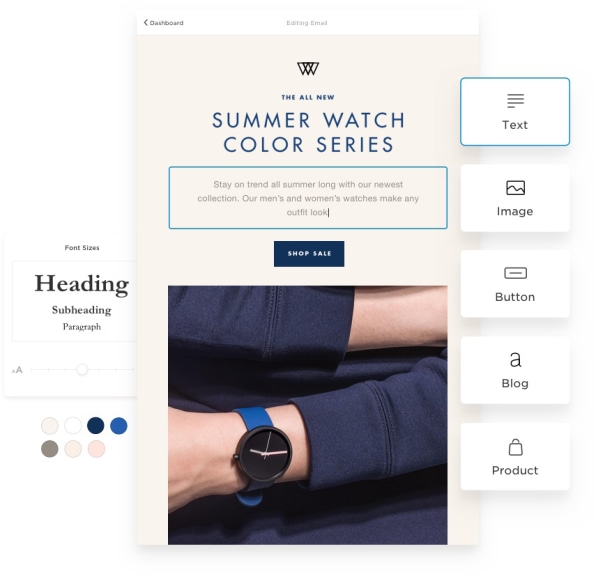

For years, Squarespace has been synonymous with beautiful homemade websites–for just $18 per month, you can have your own aspirational brand.
But Squarespace is no longer just a website builder. Over the past few years, the New York-based company has ballooned into an all-in-one platform targeted at small businesses, valued at $1.7 billion, where you can buy a domain, build a website, sell both physical and digital goods, and track analytics. Today, Squarespace is taking its first steps into the world of digital marketing with an email campaign product that’s supposed to be as pretty–and as easy to make–as a Squarespace website. “There’s a lot of things you need to do [as a small business] to be successful: You need to have a website, brand it well, be able to transact, to be able to engage with people,” says Anthony Casalena, Squarespace’s founder and CEO. “We’re going to keep trying to find those areas of opportunity where our customers have a need that would be better met on a single platform versus stitching together a bunch of different tools.”
With the rise of direct-to-consumer brands and small-scale e-commerce, Squarespace sees a market ripe for conquering. Existing tools for small companies and individuals who are running businesses online are scattershot and rarely work together well unless business owners are technically savvy–you might have a Squarespace website, linked to Google Analytics, and use Mailchimp for emails, but you can only see where your emails are pointing people to on your website if you manage to tie them all together. Casalena is betting small business owners will want to do everything through a single platform so they don’t have to deal with all the tools. That’s why Casalena is positioning Squarespace as an all-in-one place for small companies and individuals to conduct their business online, taking on giants like Wix, Shopify, and Mailchimp in the process.
UX is key. Squarespace’s new email campaign tool lets users pull in content from their Squarespace website, whether a blog post or a product page. With competing services, like Mailchimp, you typically have to copy and paste over some of your content. The emails’ analytics are also built in. Rather than having to connect MailChimp and Google Analytics to Squarespace to see how your email campaigns are driving traffic to your website, it’s all in the same place.
The emails are also designed using a similar interface to Squarespace’s popular website builder: You pick a template, then customize your email from there. The templates are centered around things like sharing a blog post, announcing a new product or a sale, promoting a product, or sending invitations. Once you’re in editing mode, each template is broken down into blocks that you can change and style to fit your brand. You can also add blocks–which include text, images, buttons, spacers, lines, blog posts, or products–anywhere you want. It took me about 10 minutes to put together a professional email for a demo website called “Really Rad Juice.”

Squarespace’s director of product Natalie Gibralter says that the company had heard from customers that email is the most important tool in their marketing, which is why she and her team started developing Squarespace’s email product about a year ago. But Casalena says the idea of an all-in-one platform has been part of Squarespace since the beginning–though when he started the company in 2003 that meant pulling together editing software, blogging software, image gallery software, and hosting. Now, it means giving website users access to commerce tools, analytics, and–you guessed it–email.
Squarespace’s email campaign service will be free for the first few months, and current users will be able to send up to 50,000 emails. Then, in late summer or early autumn, users will be asked to upgrade their account to send emails, with prices starting at $8 per month based on the number of emails you want to send.
Looking ahead, Gibralter imagines building additional tools to help small businesses with the mundane work of running a business online. Consider an analytics platform that not only tells a small business which customers opened an email, who went to its website, which products they viewed, and which products they bought, but also suggests following up with another email about a few specific products.
“Small businesses out there I don’t think are competing with an Amazon on price and logistics. They’re competing with their story,” Casalena says. “How you present your story is really important. It’s very much correlated with small business success to be able to tell a compelling story and have tools that make you look really good.”
[“Source-fastcodesign”]





